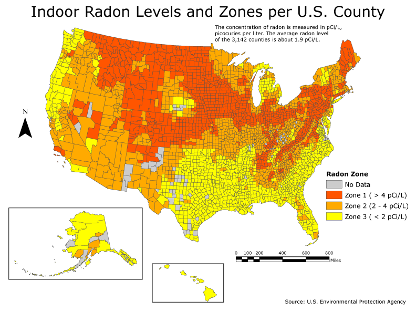SWAT Environmental is a national provider of radon mitigation services and a frequent contributor to health and safety publications. Below, the team at SWAT explains just how dangerous radon can be to American homeowners.
Radon is a silent killer. While cigarette smoking remains the leading cause of lung cancer, it’s radon — a radioactive gas — that is the
second-highest cause of lung cancer cases.
About 21,000 deaths every year in the United States are estimated to be caused by radon, according to the U.S. Environmental Protection Agency and the office of the surgeon general. It is the No. 1 cause of lung cancer in non-smokers.
And it can be found in your home. It has no taste or smell. You can’t see it, but there are ways to make sure you and your family aren’t being exposed to it.
What is Radon?
Radon is created naturally from radioactive elements breaking down or decaying. Such elements, like uranium, radium, and thorium, are found in soil and rock in varying amounts. Present outdoors and indoors, radon gas from these natural materials frequently moves into water and the air.
SWAT Environmental explains that radon is usually found in outdoor air and river and lake drinking water in relatively low amounts. However, it is found in higher levels in underground water sources, such as wells, and in the air in buildings and homes.
People can be in danger of exposure since solid elements, called radon progeny, attach to particles such as dust that we breathe. The DNA inside our body’s cells can be damaged when radon progeny in the air gives off radiation when they start to break down.
How Can I Get Exposed to Radon?
SWAT Environmental says that for those exposed to radon, the most common way is simply from breathing inside homes, offices, schools, and other public buildings that are contaminated. The risk of exposure varies depending on the type of soil and rock in the area.
So while elevated levels are found all over the United States, levels do vary greatly, even down to particular neighborhoods and areas of towns.
According to the Environmental Protection Agency, about 1 out of every 15 American homes has what would be considered
elevated radon levels. The EPA says the average indoor level of radon is 1.3 pCi/L or picocuries per liter.
People are advised to take remedial radon action when levels are measured at 4 pCi/L.
How Does Radon Gas Leak into Homes and Buildings?
SWAT Environmental explains that when soil and rocks emit radon gas, it can enter homes and other areas through everything from wall cracks to gaps in foundations. The closer a space is to the rocks and soil, the higher the potential exposure to radon gas.
That’s why those living in basements or attic spaces at their home or work are at a greater risk for exposure.
There are a few other common ways people are exposed to the gas. Some building materials are made from substances that contain radon, and sometimes radon exposure can come from granite countertops, though the levels are typically very low.


How Can I Determine If Radon Levels Are Elevated?
Testing is the key according to SWAT Environmental — and the only way to know if your home has radon levels that are elevated, excessive, and dangerous. And you must have your own home tested. A neighbor’s radon test is not an indicator of whether you have elevated levels in your own home.
Hiring a professional is going to be the most effective route here. Short-term radon detection tests can measure levels for 2-90 days, while longer-term tests can pinpoint the radon gas concentration for more than 90 days.
A long-term test is often the better way to go to get an accurate picture of your home’s radon level since levels can vary from month to month and even day to day.
There’s good news for whatever test you choose: both forms are usually inexpensive and easy for a professional to perform. There is such a thing as DIY testing but since we’re talking about something that can affect your family’s health, you may have more peace of mind leaving the testing to the pros. If you have questions about testing your local or state radon officials can provide further assistance.
SWAT Environmental says that the EPA usually lists qualified testing and remediation contractors on the website of your state’s radon office.
What Can I Do If I Think I’ve Been Exposed?
Talk with your doctor immediately. While there are no medical tests to check radon exposure that are widely available, a chat with your doctor can help determine whether a check-up is needed to look for lung cancer signs.
Lung cancer signs include chest pain and tightness, a new or bad cough, and shortness of breath. Those who smoke and are exposed to radon have a much higher risk of developing lung cancer from it than those who do not smoke.
The Bottom Line
While exposure can happen to anyone at any time, SWAT Environmental says there are easy measures to take to ensure your risk is minimal within your home or at work. Get your home tested and keep tabs on any changes to your own physical health. The best defense against radon exposure is being proactive.

